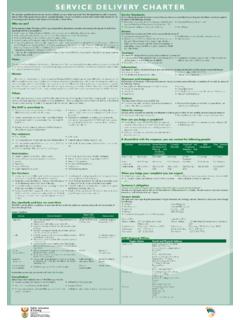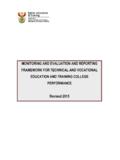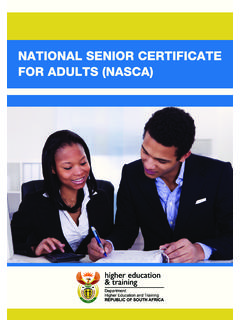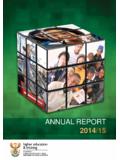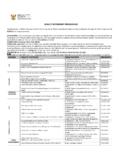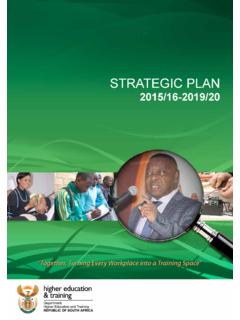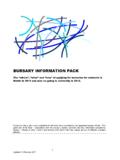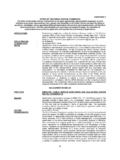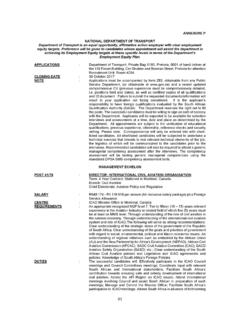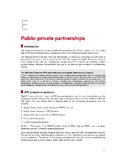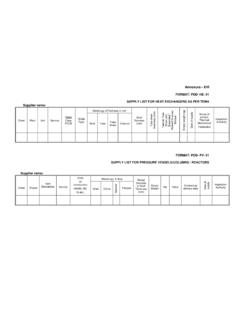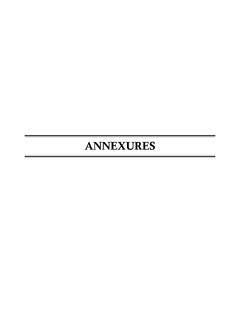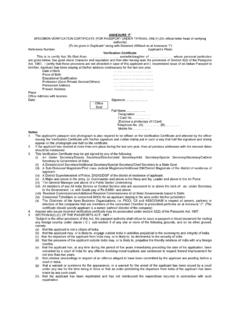Transcription of Consolidated report on lecture training - Pages
1 report ON LECTURER training CONDUCTED BY THE DoE IN PREPARATION FOR. IMPLEMENTATION OF NQF LEVEL 2 OF THE NC (V) QUALIFICATION AT FET COLLEGES. Introduction and background The lecturer training was intended to orientate lecturers to the teaching and assessment approach, and new content required by the NC(V) qualification. In addition the imperative to recognize the focus on high level knowledge and skills in this new qualification also played a key role in determining the need for lecturer training . The centralized training model was used with the DoE co-ordinating and hosting the training . This was to ensure that a coherent and consistent approach to teaching the new qualification was entrenched at this early and crucial stage. This approach is expected to have a positive impact on our first cohort of NC(V) students.
2 Whilst this centrally-driven approach might not have addressed and fulfilled the needs of individual lecturers and colleges, it did ensure that the principles and the philosophy that underpins the qualification resonated strongly and clearly. Oversight of the process by the DoE required that the training venues be located in and around the Johannesburg and Pretoria metropoles. Even though the period 23 October - 2 December 2006. required some contingency arrangements from colleges it was still deemed the least disruptive to college operations, given the number of lecturers involved in training . In future the June/July winter break would be targeted for lecturer training . Service Providers Service providers were selected on the basis of their particular expertise in the various programme specializations (list of providers attached as Annexure A).
3 A further and quite important consideration was the providers' experience and reputation in education and training . The risk of having different approaches and interpretations to the new qualification was sufficiently circumvented through briefing sessions held by the DoE with the providers before commencement of the actual training . As a result a satisfactory measure of uniformity was achieved in the training approach across all the training providers. 1. With the exception of just one all the training providers were deemed competent to complete all the training sessions to which they were contracted. Despite the different ratings (Annexure A) all service providers delivered on the key outcomes agreed to in the training contracts. Facilitators displayed individual strengths and weaknesses and these were closely monitored to make the necessary interventions.
4 training sessions were broadly divided into the following 4 segments over the 6 days: Background to the NC (V) qualification New content in the compulsory subjects under each specialization Approach to Assessment (internal and external). Teaching and Assessment year plans The DoE exercised powers of veto over the training materials prepared by the providers for the training . Selection of lecturers who participated Lecturers were selected by colleges and entered into a database at the DoE. A minimum of 2. lecturers per programme per college was allocated. Based on the availability of places and motivation from the college additional lecturers were accommodated in many instances. Forty training sessions were hosted and involved 1 861 lecturers. Annexure B reflects the sessions and Annexure C the breakdown of lecturers trained per programme and per college.
5 The discrepancy between this figure and the 1 768 indicated on Annexure C is that some lecturers could not be matched to their colleges because the registers did not capture this information. Attendance was compulsory for all 6 days and daily registers were taken. Monitoring of training sessions Monitoring of all sessions was undertaken by the DoE over the 6 week period. Although DoE. officials could not be present at training venues for all of the time there was sufficient planned presence at the sessions to ascertain the progress of the training . training providers and 2. facilitators were able to maintain regular contact with the DoE to ensure that emerging problems or issues requiring attention were dealt with immediately and decisively. The success rate and challenges of the training sessions are indicated separately in this report .
6 A standard format was provided to service providers to submit reports on the training sessions. The DoE has detailed reports from all service providers on all training conducted. Documents prepared and used in the training The Subject and Assessment Guideline documents formed the basis of all training . For the purposes of consistency and clarity exemplars of the following documents were also prepared and provided to the training providers: Proposed format for a Learning Programme (Annexure D). Assessment Schedule (Annexure E). Assessment Record Sheet (Annexure F). Lecturer's Post training Assessment- Questionnaire (Annexure G). Preparatory work for training sessions Service providers were required to submit their training plans to the DoE three weeks before the commencement of training and all training materials eight working days before the start of the respective training sessions.
7 Final lecturer name lists proved difficult to produce ahead of the sessions because of the late amendments requested by colleges. Service providers were therefore allowed to include lecturers who did not appear on the lists given to them. Venues, training resources and logistics Apart from the problems experienced at one of the venues initially selected for training (Pretoria Hof Hotel, Pretoria Central), and which was subsequently replaced, all the other training venues offered facilities conducive to training , and were well-serviced. Wherever possible the additional resources requested were made available. Requests were mainly for computers, printers and internet access. 3. Lecturer attendance and punctuality Overall lecturer attendance was good. Over the 6-day training period, late arrivals were generally recorded on day 1 (Mon mornings) and early departures on the last day (Sat).
8 A common occurrence was that poor communication between participants and colleges resulted in lecturers arriving a day or more later than the scheduled start, and at times at the incorrect venue. Punctuality was sometimes also compromised by the logistics around the accommodation and transport arrangements made for lecturers, and in some instances included early departures each day. Lecturers' participation and work discipline Overall lecturer participation was recorded to be good, and even excellent in some sessions. Active task-based participation was quite variable, influenced by both individual personality and the anticipated apprehension around dealing with something new. However it was also reported that although there was some level of nervousness and trepidation at the start of sessions, this tended to wane as the training progressed.
9 By and large lecturers did not do the preparatory reading, or bring along the SGs and AGs as requested. This necessitated voluminous photocopying just so that the training could continue as planned. As a point of interest it was observed that most of the questions posed by lecturers were non- curriculum related and seemed rather to reflect their pre-occupation with governance and management issues at the college. Quantified overall success rate of the workshop objectives and outcomes The Maths, Maths Literacy and Finance training sessions could not be reliably quantified. The qualitative reports suggest that the success rate in all of these instances would be in the region of 70%. 4. PROGRAMME % RESPONSES INDICATING THAT. OBJECTIVES WERE ACHIEVED. English 1st Add Language 75%. Life Orientation 80% +. Management 77%.
10 Marketing 88%. office Admin 84%. IT 95%. Engin & Related Design 93%. Civil Engin & Building Construction 96%. Electrical Infrast Constr 96%. Tourism 90%+. Hospitality 90%+. Some of the challenges experienced The following presented particular challenges to the training objectives: Lecturers deployed to teach in an NC(V) programme outside the ambit of their experience or qualifications expressed a lack of specialist subject knowledge Lecturers exposure to and knowledge of Skills Programmes and Learnerships offered by SETAs interfered with their understanding of normal teaching, assessment and administrative requirements at colleges Divergent, and sometimes unrealistic expectations of participants about what should be achieved in the training session. This ranged from expectations to be taught all of the content contained in the curriculum, to being trained to be workshop trainers for other lecturers Cognitive limitations of some lecturers to grasp concepts, content and methodology posed definite barriers Inherent resistance to change and implementation of anything new Die-hard support for the old' N1-N3 programmes and unhappiness at its phasing out 5.
